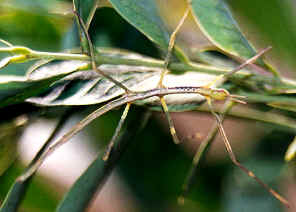Tessellated Phasmatid - Ctenomorphodes tessulatus
This page contains pictures and information about the Tessellated Phasmatids that we found in the Brisbane area, Queensland, Australia.
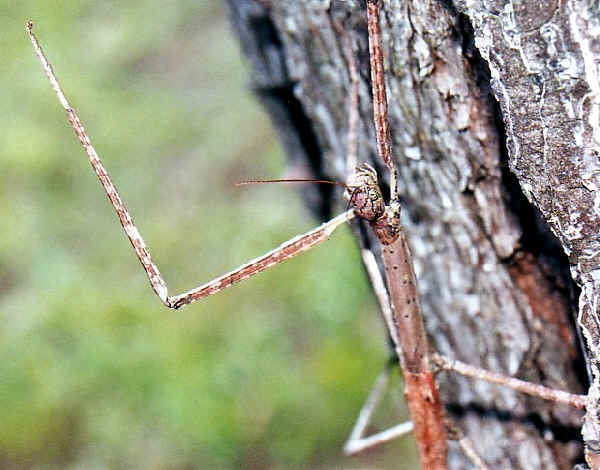
- Female, body length 140mm
- The female and male Tessulata Stick Insects look a bit different. The females are larger in size. On its small head there are two big compound eyes and antennae about 20mm in length, shorter than the male. The thorax is 30mm long and with some black dots. Tegmina, or the forewings are 15mm long. Hind wings 30mm long, covered two and a half abdominal segments. All six legs are spiny. There are ten segments easily seen on its abdomen. On the end, there are two leaf-like cerci about 10mm long. We have found four females so far, they are vary in colour, from brown to pale green. However, the Tegmina are always in brown colour.
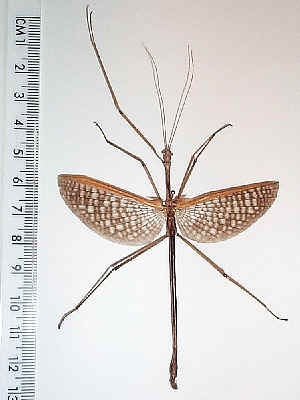
- Male, body length 80mm
- The picture shows the male tessulata that we found on our windows outside and was entangled by a spider web. Showing that its may attracted by windows light and flied to the web. It was dead when we unload it from the web. One of its first leg was missing. The males are smaller in size that the female. However its antenna and hind wings are longer, with the antenna 35mm and hind wings 40mm long. Tegmina, or the forewings are 10mm long. Its thorax is 15mm and the ten segmented abdomen is 60mm long. It has two row of black dots on it thorax. Its front leg has no spines while all four hind legs are spiny. On the end, there are two leaf-like cerci about 10mm long. We have found three male so far and all are the same colour.
Eggs
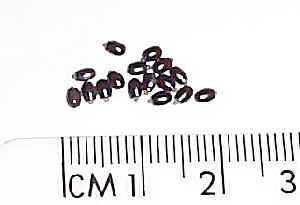
- Eggs are 3mm long, dark brown to black in colour. The stick insect drop the eggs to ground during summer. They will hatch in August to September 2001. Pleas come black to this page later to see how we go on hatching those eggs (see below).
Their Habitat


- Tessellated Phasmatid mainly feed on eucalyptus but also adapt to other trees and grasses. Most other species of stick insects usually are low in population, but this species is known to occur in plague proportion from time to time.
Records on where they were found
Followings are the details about each Tessellated Phasmatid that we found;
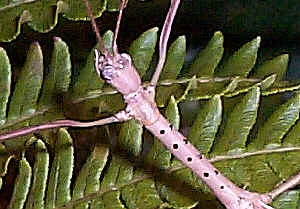
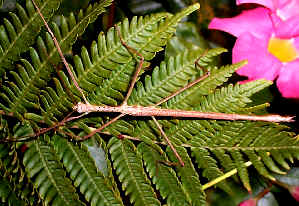
- Male, body length 80mm
- We found this male stick insect in Moreton Island in mid summer. They fly actively and we found some of them flying to window lights. They are brown in colour with two lines of fine small black dots on their thorax. Their bodies are slender with short forewings cover only the base of their hind wings.
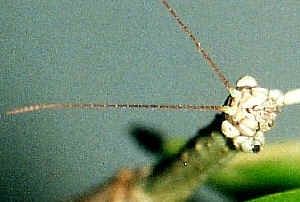
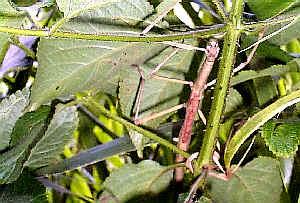
- Female, body length 140mm
- We found this Green Stick Insect during we were bush-walking in Mansfield bush land along the Bulimba Creek. It was two days after a heavy rain storm. The stick insect was actively moving so we can see it easily. The time was about 5:00pm. We then pick a branch of twigs, let the insect climbed on it and then brought it home to have more study. The Stick Insect is grass-green in colour, with brownish-green forewings. Its forewings are small, about 10mm in length and cover only part of its hind wings. Its hind wing is 25mm in length, cover half of its abdomen. Its front right leg was missing. Its antenna is combatively short, about 20mm. It feed on the gum tree leaf but it did not eat a lot. It die after six days. It lay 16 eggs during the days we kept it. Its eggs are black in colour, with a plug and look like seeds.
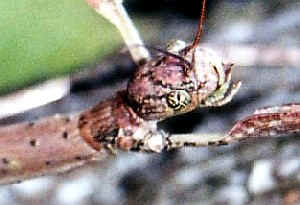
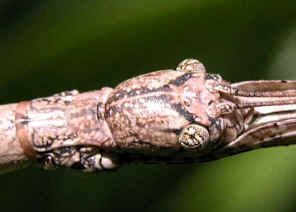
- Female, body length 150mm
- This Brown Stick Insect was found resting on the trunk of a big pine tree in a park in Wishart. The Stick Insect is grayish-brown in colour, with brown bark like marking on forewings and abdomen. It seems to resemble eucalypt stems and twigs. Its forewings are small, about 10mm in length and cover only part of its hind wings. Its hind wing is 25mm in length, cover half of its abdomen. Its antenna is combatively short, about 20mm. Its body shape is the same as the Green Stick Insect (see above) but with stronger legs. There are some black dots disturbute on it long thorax. Although we have some experience in keeping Stick Insect, it die three days after we brought it home. Within those days it lay 36 eggs. Its eggs, similar to the Green Stick Insect, are black in colour, with a plug and look like seeds.

- Female, body length 150mm
- We found this female stick insect under a Eucalypt tree in a young Eucalypt bush. Both of its front pair of legs are lost. It is brown in colour. We took it home for a few days, it laid 20 eggs.

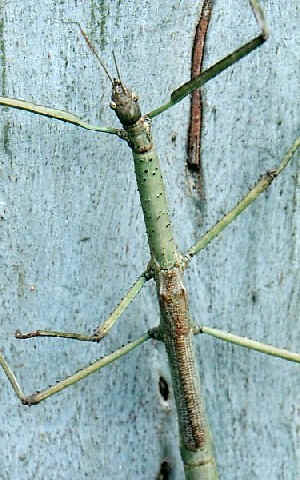
- Male, body length 80mm. Female, body length 140mm.
- Both male and female found in Wishart in the same day in late summer. The male has one of its forelegs missing. All the three males we had seen are in the same colour form. This female's body is pale green and the wings are pale brown in colour. The female stick insect was trying very hard to climb up the tree.
Mating
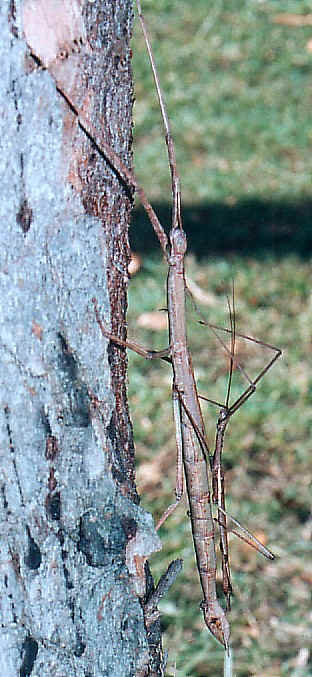
- We found the mating couple on an eucalyptus tree trunk 0.5 meter above ground. It was May 2001 and was the early winter in Brisbane. We let them climb on a stick and took them home for study. They remained in the mating position for a few hours. The male stick insect die two days later. The female laid 150 eggs within a week and then die as well.
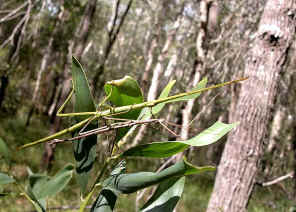
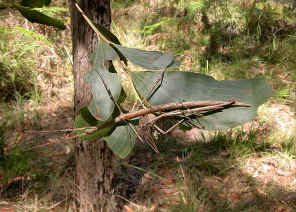
- They can be found on wattle trees as well. Above pictures was taken in Mt Cotton, where the Tessulata Stick Insects were easy to found during mid summer..
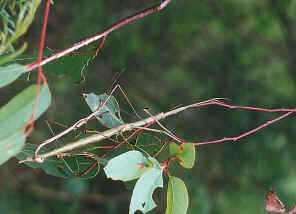
The Instars
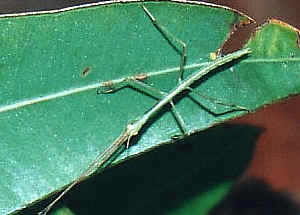

- 1st instars, 14mm.
- As we predicted (on top of this page), those eggs star to hatch on mid August 2001. They are 13-15mm in body length. They are very active, walking around up and down in the breeding tank. When rest, they like to rest on the top of the tank or on the bright side of the tank. They look exactly as theirs mothers except wingless and with very short antenna, They sit like their mother too.
- 2nd instars 20mm, later instars 60mm
- Not much different from the 1st instars except a little bit larger.
Questions for Discussion
Tessellated Phasmatids are usually living on the top of the trees, why we can find them near the ground?
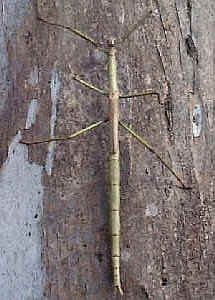
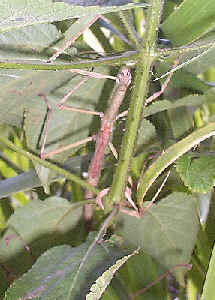
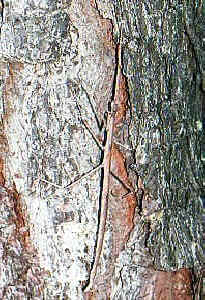
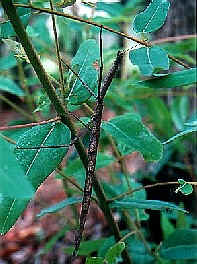
- Female Tessellated Phasmatids vary in colour from brown to pale green. They should live high on the tree, but we found them all near the ground, either in the bush or on the tree trunk. When we bring them home, they all lay eggs in the first day.
We read the reference books that stick insects are usually living on the top to the tree. After storm some of them may fall to the ground so that we can occasionally find them near the ground. Especially for the female stick insects, there seem no other reasons that they should leave the tree top and go down to the ground. From our experience, we found five female Tessellated Phasmatid during summer season in 2001. Two of them are found in the lower plants under large gum trees. Three of them are resting on the trunk of trees and trying to climb back to the top. Only one female stick insect we found was two days after heavy rainfall. All the others were found without any bad weather. (Since in Brisbane we usually have good weather, bad weather days are easily remember.) It seems that they are not fall to the ground because of bad weather.
We had taken four of them back home to study. All four female stick insects lay some eggs during we keep them. Some of them die within a few days. So I think the stick insects were not fall down due to bad weather, they went down to some good locations to lay their eggs. To prove that we should try to find out what is the favorable site for stick insects to lay their eggs. Those sites could be the wet soil with young trees and new plants. We should try to find out that the Tessellated Phasmatid in the wild will come down and look for a place for laying eggs, instead of just dropping their eggs from the tree.
Go down from the tree may increase their chance of being prey, it could be worth to do that if this increase the hatching chance of their offspring. This may not decrease their fitness too much for they will die after laying eggs anyway.
This can also explain why we seldom see the nymph Tessellated
Phasmatid in the wild, for they no need to take the risk to come down.

